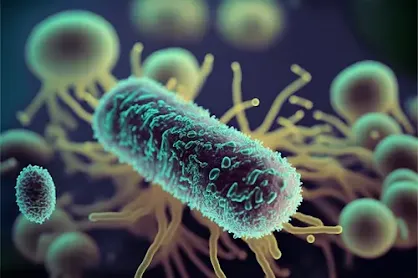Bacteria are prokaryotic microorganisms typically having cell walls made of peptidoglycan and reproducing by binary fission. They are microorganisms with a single cell and they constitute some of the most numerous and diverse organisms on Earth and are essential to many different ecosystems.
Bacteria lack a nucleus and other membrane-bound organelles. They have wide range of shape, structures and characteristics when observed under microscope and passed through biochemical tests. They have three primary categories depending on shape, which are cocci (spherical or oval-shape), bacilli (rod-shaped) and spirilla (rigid spiral structure).
In relation to habitat and undertaking life processes, bacteria are host or environment specific. Due to their morphological modifications, bacteria interact with their environment and inhabit a variety of habitats that favor their growht.
Some bacteria species can thrive in soil whiles others multiply in water, food, artifact surfaces and host organisms including humans.
The atmosphere or air also serve as habitat for some genus of bacteria. Most importantly, the air is a medium for their transport. It facilitates bacteria movement from one medium or space to the host organisms.
Here in this scientific article are examples of bacteria that are associated with air.
 |
| E. coli in the intestine of human |
1. Escherichia coli
Escherichia coli commonly known as E. coli, is a Gram-negative, rod-shaped bacterium. It is commonly found in the intestinal tract of humans and animals. Most strains of E. coli are harmless and are essential part of the gut microbiome, aiding in digestion and the production of vitamins. However, E. coli is also pathogenic, some strains, such as E. coli O157, can cause foodborne illness, leading to symptoms like diarrhea, abdominal pain, and vomiting. E. coli is also used extensively in scientific research and biotechnology due to its ease of cultivation and genetic manipulation.
E. coli is primarily an anaerobic bacterium, meaning it thrives in environments without oxygen. However, it is also a facultative anaerobe, which allows it to survive and grow in the presence of oxygen. This adaptability is the key feature that helps E. coli to thrive in various environments, including air.
.webp) |
| S. aureus under electrinic microscope |
2. Staphylococcus aureus
Staphylococcus aureus (S. aureus) is a Gram-positive, spherical bacterium that can be found on the skin and mucous membranes of humans. It is known for causing a variety of infections, ranging from minor skin infections to life-threatening diseases such as pneumonia and bloodstream infections. Air serves a basic role of transport for Staphylococcus aureus to move from host surface to another host since it is found on the skin and in mucous.
 |
| Streptococcus pneumoniae in lungs |
3. Streptococcus pneumoniae
Streptococcus pneumoniae, or pneumococcus, is a Gram-positive, lancet-shaped bacterium that commonly colonizes the upper respiratory tract. It is a leading cause of bacterial pneumonia, as well as other infections such as meningitis and otitis media.
In terms of survival in the air, S. pneumoniae is relatively sensitive to environmental conditions, particularly drying and exposure to sunlight or oxygen. It does not thrive in open air for extended periods but can survive long enough to infect new hosts through close contact or respiratory droplets.
 |
| Mycobacterium tuberclosis under electron microscope |
4. Mycobacterium tuberculosis
Mycobacterium tuberculosis is a slow-growing, acid-fast bacterium responsible for causing tuberculosis (TB), a contagious airborne disease. It is characterized by its rod-shaped morphology and unique cell wall composition, which includes mycolic acids. M. tuberculosis is a significant global health concern and this bacterium association with air has attracted several attention for research.
 |
| Pseudomonas aeruginosa under electronic microscope |
5. Pseudomonas aeruginosa
Pseudomonas aeruginosa is a Gram-negative, rod-shaped bacterium commonly found in soil, water, and moist environments.
It is an opportunistic pathogen that can cause infections in individuals with weakened immune systems, such as those with cystic fibrosis or hospitalized patients. P. aeruginosa is known for its antibiotic resistance and ability to form biofilms.
 |
| Gram stained Bacillus subtilis |
6. Bacillus subtilis
Bacillus subtilis is a Gram-positive, rod-shaped bacterium commonly found in soil and the gastrointestinal tract of humans and animals.
It is widely used as a model organism for studying cellular processes and has applications in biotechnology, including the production of enzymes and antibiotics.
 |
| Salmonella enterica under electronic microscope |
7. Salmonella enterica
Salmonella enterica is a Gram-negative, rod-shaped bacterium that includes several serovars known for causing foodborne illnesses. It is typically associated with contaminated food, particularly raw poultry, eggs, and unpasteurized dairy products.
Salmonella infections can lead to gastroenteritis, with symptoms such as diarrhea, abdominal cramps, and fever.
 |
| Helicobacter pylori in human stomach |
8. Helicobacter pylori
Helicobacter pylori is a Gram-negative, spiral-shaped bacterium that inhabits the stomach lining of humans. It is associated with the development of gastritis, peptic ulcers, and gastric cancer. H. pylori has a unique ability to survive in the highly acidic environment of the stomach.
H. pylori does not thrive in oxygen-rich environments. Its natural habitat is within the stomach's acidic environment, where oxygen levels are minimal. Only that the bacteria are typically transmitted from person to person through oral-oral or fecal-oral routes rather than via airborne transmission.
 |
| Streptococcus pyrogenes growth on blood agar |
9. Streptococcus pyogenes
Streptococcus pyogenes (S. pyogenes) is a Gram-positive bacterium responsible for a range of infections in mammals. It can cause strep throat, impetigo, cellulitis, pneumonia, and more severe conditions like necrotizing fasciitis and streptococcal toxic shock syndrome.
S. pyogenes does not thrive in open air as a natural habitat but it survives and spreads via airborne droplets when an infected person cough, sneezes or talks. The bacteria can remain viable for a short period on surfaces and in the air, facilitating transmission.

.jpeg)

.jpeg)





.jpeg)

Please share your thoughts with us